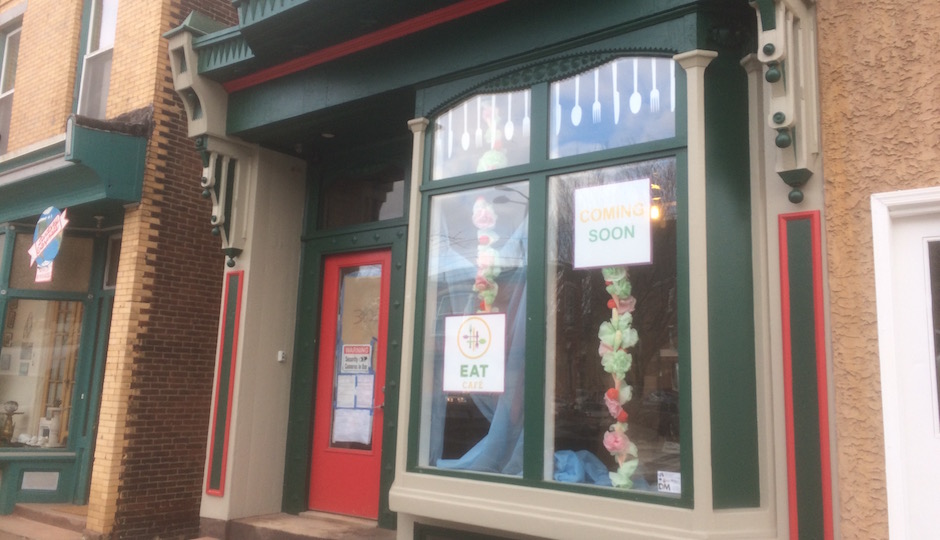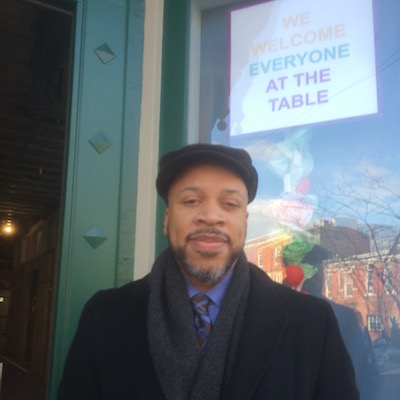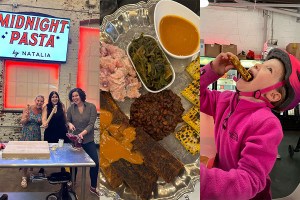New Restaurant Lets “Everyone At the Table” Build Community

The future home of the EAT Cafe on Lancaster Avenue where Powelton Village and Mantua meet. Photos | Sandy Smith
Can a restaurant fight hunger and build community at the same time?
The answer to this question would seem obvious. A restaurant serves food, so of course it fights hunger. And it brings people in from outside to dine, often frequently, so it can become a community hub as well.
But throw in food insecurity, and broaden that community to include poor people struggling with that issue, and the answer becomes much less obvious. A typical restaurant isn’t set up to accommodate the truly hungry, nor can it handle those who may not be able to afford the cost of a meal.
The EAT Cafe on Lancaster Avenue, set to open this spring, isn’t a typical restaurant. Instead, it’s the first example in Philly of a model that tackles that other form of hunger-fighting and community-building, one that has popped up in more than 100 cities across the country.
EAT stands for “Everyone At the Table,” and the way it will bring everyone to the table is by allowing patrons to pay what they wish for their meals. Backed by a collaboration between Drexel University’s Center for Hunger-Free Communities and the Vetri Community Partnership, the restaurant will use food to promote civility and neighborliness while combating food insecurity.
The EAT Cafe is similar to what the Vetri Community Partnership is already doing in the city’s public schools with a program that has children eating lunch family-style, so it immediately appealed to Marc Vetri’s nonprofit, the foundation said. “We’ve been able to quantify over the last five years that communal eating has measurable psychosocial benefits,” said Jeff Benjamin, chief operating officer of Vetri Family Restaurants and co-founder of the Partnership.
Vetri, who also teaches at Drexel, had seen a documentary about “Witnesses to Hunger,” one of the Center for Hunger-Free Communities’ signature programs, and decided his foundation needed to be involved with the center. Benjamin said, “We contacted Mariana Chilton,” the center’s director, “and we both had the same ends in sight.” Chilton, it turns out, was already at work on a project that would open a restaurant where all could dine with dignity regardless of income. “She was intrigued by what Jon Bon Jovi was doing in Red Bank” — the JBJ Soul Kitchen, where the menu items have no prices and patrons can either pay what they can or do volunteer work to pay for their meals.
“The idea germinated with them first,” Benjamin said. “Then, when we contacted them, it was like, ‘Hey, these are food guys, and we want to start a cafe. Let’s talk.”
The EAT Cafe will operate slightly differently from Bon Jovi’s restaurant. The menu, which will change daily, will feature three-course meals with soup or salad, a main course, and dessert for a fixed price. (The menu will also include vegetarian and gluten-free options, with at least two main dishes available every day.) Guests will eat at communal tables, and when the check comes, patrons may pay the amount on the check, pay more than the menu price, pay less than the menu price, or pay nothing at all.
For this model to work, it will require a steady stream of customers who will gladly pay more for their meals. Kate Scully, policy director at the Center for Hunger-Free Communities, says that the combination of quality, healthy food and an inviting atmosphere will bring those patrons back the way they come back to similar restaurants elsewhere: “They’re successful because the food is good.”

EAT Cafe Executive Chef Donnell Jones-Craven
The person charged with that crucial mission is Donnell Jones-Craven, the cafe’s executive chef, who has an extensive background in food service for nonprofits and contractors, quick-service restaurants, hotel and catering kitchens, and healthcare. He noted that the emphasis will be on fresh, seasonal and locally sourced ingredients, utilizing both producers such as Greensgrow Farm and supplier partners such as Ahold USA, operator of the Giant food stores in this region. The Vetri organization is providing operational support for the restaurant as well.
But he, too, is as passionate about the mission as he is the cuisine: “I’ve always had a strong community mindset,” he said, “working in hospitals and senior citizen communities.” He envisions the space as a gathering place for people from all walks of life and from both the surrounding neighborhoods and beyond. In addition to food, the cafe will also serve up local artists and performers as a way of both attracting repeat customers and creating a neighborhood hangout. One of the regular events he would like to host, for instance, is a traditional Sunday dinner, at which local church choirs might perform.
“We want to make a cafe where a longtime citizen of the community, who is retired, maybe the kids live far away, and not really engaged with the community, they can come and have a meal in the afternoon or evening, and an attorney who works downtown, or a professor at Drexel, can sit at the same table, and they can have a dialogue, which these individuals [otherwise] wouldn’t intersect at all,” Jones-Craven said. “We hope this cafe will be that point of intersection for this community.”
“A lot of times, people who are struggling to make ends meet feel isolated and don’t always have access to nutritious food, and don’t always feel that they can go somewhere and have a nice meal,” said Callie Perrone, the center’s community engagement and communications fellow. “[Chilton] wanted to create a place where a doctor at Presbyterian, a mom who’s struggling to make ends meet, can come and have a nice wholesome dinner without any judgement or stigma.”
Jones-Craven said the cafe’s initial marketing and outreach is focusing on two groups: senior citizens and millennials. To tap the latter market, he’s using vehicles like Uwishunu, the hip things-to-do guide sponsored by Visit Philadelphia. For the former, he and the folks at the Center are relying on less tech-y channels: visits to neighborhood civic groups, senior centers, housing facilities and suchlike.
“This is a model that’s being used across the country,” Scully said. “It’s just the first time it’s being used in Philadelphia.” It’s also one of the first such establishments to be set up in a large city: Most of the pay-what-you-can restaurants currently operating are located in smaller towns and cities.
The EAT Cafe is slated to open sometime this spring.
[Updated 4:47 p.m. March 7 to correct an identification.]
Follow Sandy Smith on Twitter.


